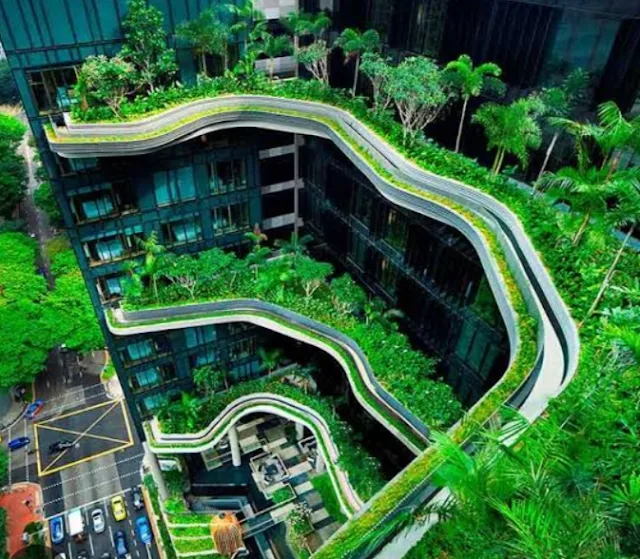Singapore's Green Energy Landscape: A Climb Towards Sustainability
Singapore, a small island nation with limited natural resources, faces a unique challenge in its pursuit of a sustainable energy future.
While currently heavily reliant on imported natural gas, the city-state has embarked on an ambitious journey to green its energy mix and combat climate change. This article delves into the evolving landscape of Singapore's green energy sector, exploring initiatives, achievements, and the road ahead.
Current Energy Landscape:
- Dominant Source: Natural gas accounts for roughly 95% of Singapore's electricity generation, making it a relatively cleaner fossil fuel compared to coal.
- Limited Renewables: Due to land scarcity and low wind speeds, renewable energy currently contributes less than 2% of the energy mix. However, this number is rising steadily.
Driving the Green Shift:
- Policy Push: The Singaporean government plays a crucial role with initiatives like the Green Plan 2030 and ambitious solar deployment targets.
- Innovation Hub: Singapore actively fosters research and development, focusing on areas like solar cell efficiency and energy storage solutions.
- Market Mechanisms: The Energy Market Authority (EMA) implements carbon pricing and feed-in tariffs to incentivize clean energy adoption.
Solar Power Takes Center Stage:
- Growing Capacity: Singapore aims for at least 2 gigawatt-peak (GWp) of installed solar capacity by 2030, representing a significant increase from the current 0.75 GWp.
- Innovative Deployments: Solar panels are integrated into various urban spaces, including rooftops, facades, reservoirs, and even carparks.
- Public-Private Partnerships: Collaborative projects like the Jurong Island solar farm showcase the combined efforts of government and private entities.
Beyond Solar:
- Regional Collaboration: Singapore participates in regional energy initiatives like the Southeast Asia Regional Integration of Power and Energy Markets (ASEAN REM), promoting cross-border renewable energy trading.
- Exploring New Frontiers: Studies on offshore wind, geothermal, and hydrogen are underway, seeking potential diversification of the energy mix.
- Embracing Carbon Capture and Storage (CCS): The Jurong Island CCS project represents a significant step towards capturing and storing emissions from natural gas power plants.
Key Statistics:
- Current Carbon Footprint: 55 million tonnes of CO2 equivalent (MtCO2e) in 2022, aiming for 38 MtCO2e by 2030 and net-zero by 2050.
- Investment in Green Energy: S$9 billion (US$6.6 billion) committed by the government between 2020 and 2025.
- Number of Green Jobs: Expected to reach 2,700 by 2032, a potential increase of 80% compared to 2020.
Challenges and Opportunities:
- Land Scarcity: Finding space for large-scale renewable energy projects remains a challenge.
- Cost Competitiveness: While declining, renewable energy costs still need to compete effectively with traditional sources.
- Integration with the Grid: Managing the intermittency of renewable energy sources requires innovative grid management solutions.
Looking Ahead:
Singapore's green energy journey is one of ambition and innovation. Despite its limitations, the nation is determined to build a sustainable future. By harnessing solar power, exploring new technologies, and fostering collaboration, Singapore aims to set an example for other countries facing similar challenges. The success of its green energy transition will be closely watched, offering valuable lessons for the global fight against climate change.
Patterns Emerging in Singapore's Green Energy Landscape
Examining Singapore's green energy journey reveals several key patterns:
1. Ambitious Goal Setting: The government plays a central role by establishing ambitious targets for renewable energy deployment, carbon emission reduction, and net-zero goals. This creates a clear direction and motivates stakeholders to invest and innovate.
2. Focus on Innovation and Technology: Recognizing its limited land and natural resources, Singapore prioritizes technological advancements to enhance the efficiency and affordability of renewable energy solutions. This includes research on solar cell efficiency, energy storage, and integrating renewables into existing infrastructure.
3. Policy and Market Mechanisms: The government leverages policy tools like carbon pricing, feed-in tariffs, and grants to incentivize clean energy adoption. Additionally, the Energy Market Authority (EMA) implements market mechanisms to encourage competition and efficient energy trading.
4. Public-Private Partnerships: Collaboration between the government and private sector is crucial for financing, developing, and deploying large-scale renewable energy projects. Examples include the Jurong Island solar farm and the Jurong Island CCS project.
5. Regional Collaboration: Recognizing the interconnectedness of the region, Singapore actively participates in initiatives like ASEAN REM to facilitate cross-border renewable energy trading and promote regional energy security and sustainability.
6. Focus on Solar Power: Due to its suitability for urban environments and potential for scalability, solar energy has become the cornerstone of Singapore's green energy strategy. This includes rooftop, facade, reservoir, and carpark installations, along with exploring offshore solar farms.
7. Diversification Efforts: While solar power leads the charge, Singapore is also exploring other renewable sources like offshore wind, geothermal, and hydrogen. This diversification aims to address land constraints and create a more resilient energy mix.
8. Integration with Existing Infrastructure: Integrating renewables into existing infrastructure, like buildings and transportation networks, is crucial to maximize space utilization and minimize disruption. This includes building-integrated photovoltaics (BIPV) and electrifying public transport.
9. Emphasis on Green Jobs: The transition to a green economy creates new job opportunities in various sectors, including renewable energy development, energy efficiency, and circular economy practices. The government actively supports green job training and development.
10. Continuous Learning and Adaptation: Singapore's green energy landscape is constantly evolving as new technologies emerge, costs decrease, and societal needs change. The government and stakeholders adapt their strategies based on ongoing learning and feedback, ensuring the path towards sustainability remains dynamic and effective.
By understanding these patterns, we can gain valuable insights into the potential future of Singapore's green energy landscape and its role in leading the region towards a sustainable future.
Singapore's Green Energy Landscape: Key Data Overview
| Category | Statistic | Source/Year |
|---|---|---|
| Current Energy Mix | ||
| - Natural Gas | ~95% of electricity generation | EMA, 2023 |
| - Renewables | <2% of electricity generation | EMA, 2023 |
| Solar Power | ||
| - Installed Capacity | 0.75 GWp | EMA, 2023 |
| - Target Capacity by 2030 | 2 GWp | Singapore Green Plan 2030 |
| Carbon Footprint | ||
| - Current Emissions | 55 MtCO2e | Ministry of Sustainability and the Environment (MSE), 2022 |
| - Target Emissions by 2030 | 38 MtCO2e | Singapore Green Plan 2030 |
| - Target for Net-Zero | 2050 | Singapore Green Plan 2030 |
| Investment | ||
| - Government Green Energy Investment (2020-2025) | S$9 billion (US$6.6 billion) | Singapore Green Plan 2030 |
| Green Jobs | ||
| - Current Green Jobs | ~1,500 | EMA, 2022 |
| - Projected Green Jobs by 2032 | 2,700 | Singapore Green Plan 2030 |
Gazing into the Emerald Future: Singapore's Green Energy Landscape
Singapore's pursuit of a sustainable future hinges heavily on transforming its energy landscape. While the current path is paved with ambitious goals and promising strides, the question remains: what does the future hold for Singapore's green energy scene? Let's delve into some potential scenarios:
Solar Power Ascendance:
- Dominant Force: Solar energy could become the dominant source of electricity, exceeding even the ambitious 2 GWp target by 2030. Technological advancements might drive down costs further, making rooftop and facade installations ubiquitous. Floating solar farms could maximize land usage, while offshore farms harness ocean energy.
- Smart Integration: Advanced grid management systems would seamlessly integrate solar power with other renewables, ensuring stability and reliability. Blockchain technology could play a role in energy trading and peer-to-peer sharing, democratizing energy access.
Beyond Solar:
- Emerging Renewables: Wind power could take root offshore, harnessing stronger wind speeds. Geothermal energy, currently under exploration, might contribute significantly, especially if suitable underground resources are found. Hydrogen, produced through renewable energy sources, could power transportation and even be stored for electricity generation.
- Regional Collaboration: Singapore's role as a regional energy hub could expand, facilitating renewable energy trading across Southeast Asia through initiatives like ASEAN REM. This could create a larger market for clean energy, boosting its affordability and competitiveness.
Sustainability Beyond Energy:
- Embracing Circular Economy: Green energy production and consumption could be integrated with circular economy principles, minimizing waste and maximizing resource efficiency. This could involve using recycled materials for solar panels and wind turbines, or reusing batteries from electric vehicles for energy storage.
- Nature-based Solutions: Enhancing green spaces and incorporating nature-based solutions like urban forests could not only mitigate carbon emissions but also improve air quality and water management, creating a more sustainable and resilient urban environment.
Possible Challenges:
- Cost and Efficiency: Despite advancements, cost-competitiveness of renewable energy compared to traditional sources remains a concern. Further research and development are crucial to improve efficiency and affordability.
- Land Scarcity: Finding suitable land for large-scale renewable projects like wind farms could pose a challenge, necessitating innovative solutions like floating platforms or integrating renewables into existing infrastructure.
- Social Acceptance: Public acceptance of certain technologies, like offshore wind farms, might need to be addressed through community engagement and transparent communication.
Conclusion:
The future of Singapore's green energy landscape is brimming with possibilities. While challenges exist, the nation's commitment to innovation and collaboration, coupled with its ambitious goals, positions it well to lead the region in its transition towards a sustainable future. By embracing technological advancements, fostering regional collaboration, and integrating sustainability into all aspects of energy production and consumption, Singapore can create a truly emerald future for its citizens and the planet.
Remember, this is just a glimpse into the potential future. The actual path will likely involve a mix of these scenarios, shaped by unforeseen developments and ongoing efforts.




